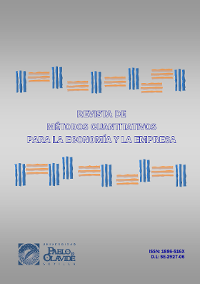Análisis bayesiano para la diferencia de dos proporciones usando R
DOI:
https://doi.org/10.46661/revmetodoscuanteconempresa.2129Palabras clave:
Estimación, funciones en R, inferencia bayesiana, proporciones, Bayesian inference, estimation, proportions, R functionsResumen
Este artículo presenta una colección de funciones computacionales que son utilizadas en la implementación de un análisis bayesiano exhaustivo para la diferencia de dos proporciones. Con este fin, se discute la estimación puntual, la estimación mediante intervalos de credibilidad y la inferencia predictiva desde dos escenarios: el primero basado en las densidades exactas a priori y a posteriori (construidas mediante la primera función hipergeométrica de Appell) y el segundo basado en densidades simuladas (mediante un algoritmo de cadenas de Markov con métodos de Monte Carlo). La implementación de estas funciones se realiza en el programa estadístico R, porque es un software libre, funciona bien en múltiples plataformas y permite enmarcar estas funciones bajo un objeto computacional denominado “paquete”.
Descargas
Citas
Agresti, A. & Coull, B. A. (1998), ‘Approximate is better than exact for interval estimation of binomial proportions’, The American Statistician 52(2), 119–126.
Agresti, A. & Min, Y. (2005), ‘Frequentist performance of bayesian confidence intervals for comparing proportions in 2 × 2 contingency tables’, Biometrics 61, 515–523.
Albert, J. (2007), Bayesian Computation with R, Springer.
Bailey, W. N. (1934), ‘On the Reducibility of Appell's Function F4’, Quart. J. Math 5, 291–292.
Canavos, G. C. (1988), Probabilidad y estadística: aplicaciones y métodos, McGraw-Hill.
Carlin, B. P. & Louis, T. A. (1996), Bayes and Empirical Bayes for Data Analysis, 1 edn, Chapman and Hall/CRC.
Fisher, R. A. (1970), Statistical Methods for Research Workers, 15 edn, Macmillan Pub. Co.
Gamerman, D. & Lopes, H. F. (2006), Markov Chain Monte Carlo, Chapman and Hall/CRC.
Gelman, A. (2008), ‘Objections to bayesian statistics’, Bayesian Analysis 3(3), 445–450.
Gelman, A., Carlin, J. B., Stern, H. S. & Rubin, D. B. (1995), Bayesian Data Analysis, 1 edn, Chapman and Hall/CRC.
Jack, A., Woodard, D., Hoffman, J. & O’Connell, M. (2007), Bayesian Modeling with S-PLUS and the flexBayes Library, Insightful Corporation.
Jeffreys, H. (1961), The Theory of Probability, Oxford.
Magidson, J. (1982), ‘Some common pitfalls in causal analysis of categorical data’, Journal of Marketing Research 19, 461–471.
Magidson, J. (2004), ‘Epidat 3.0: programa para análisis epidemiológico de datos tabulados’, Revista Española de Salud Pública 78(2), 277–280.
Pham-Gia, T. & Turkkan, N. (1993), ‘Bayesian analysis of the difference of two proportions’, Communications in Statistics: Theory and Methods 22(6), 1755–1771.
Pope, J. L. (1984), Investigación de mercados. Guía maestra para el profesional, Grupo Editorial Norma.
R Development Core Team (2008), R: A Language and Environment for Statistical Computing, R Foundation for Statistical Computing, Vienna, Austria.
SAS (2006), Preliminary Capabilities for Bayesian Analysis in SAS/STAT Software.
Spiegelhalter, D., Thomas, A., Best, N. & Lunn, D. (2004), WinBUGS User Manual.
Descargas
Publicado
Cómo citar
Número
Sección
Licencia
Derechos de autor 2009 Revista de Métodos Cuantitativos para la Economía y la Empresa

Esta obra está bajo una licencia internacional Creative Commons Atribución-CompartirIgual 4.0.
El envío de un manuscrito a la Revista supone que el trabajo no ha sido publicado anteriormente (excepto en la forma de un abstract o como parte de una tesis), que no está bajo consideración para su publicación en ninguna otra revista o editorial y que, en caso de aceptación, los autores están conforme con la transferencia automática del copyright a la Revista para su publicación y difusión. Los autores retendrán los derechos de autor para usar y compartir su artículo con un uso personal, institucional o con fines docentes; igualmente retiene los derechos de patente, de marca registrada (en caso de que sean aplicables) o derechos morales de autor (incluyendo los datos de investigación).
Los artículos publicados en la Revista están sujetos a la licencia Creative Commons CC-BY-SA de tipo Reconocimiento-CompartirIgual. Se permite el uso comercial de la obra, reconociendo su autoría, y de las posibles obras derivadas, la distribución de las cuales se debe hacer con una licencia igual a la que regula la obra original.
Hasta el volumen 21 se ha estado empleando la versión de licencia CC-BY-SA 3.0 ES y se ha comenzado a usar la versión CC-BY-SA 4.0 desde el volumen 22.










